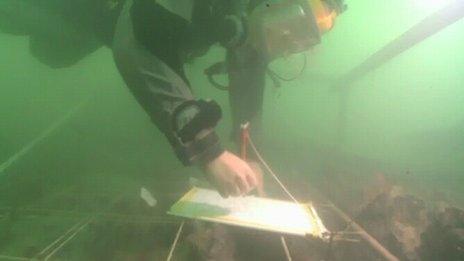Solent's Stone Age village 'washing away'
- Published

In 1999, a team of divers off the Isle of Wight came across a lobster busily digging out its burrow. To their surprise they found it was kicking out flints from the Stone Age. However, archaeologists now fear artefacts dating back more than 8,000 years are simply being "washed away".
Bouldnor Cliff is a submerged Stone Age settlement off the coast of Yarmouth which was covered in silt as great sheets of ice melted at the end of the last Ice Age.
It is an important site because the muddy conditions have helped preserve organic materials from the distant past that do not normally survive on dry land.
The materials date back to a time when the Isle of Wight did not exist and it was possible to walk from Britain to what is now France.
"This is an element of our history that is being lost from a unique site. It can add new insights into our human journey from nomad to settler," said Garry Momber, director of the Maritime Archaeology Trust.

Hazelnuts, perfectly preserved leaves and a piece of string which dates to 8,000BP (6,000BC) have been found in the multi-layered sandwich of peat and silt.
Hundreds of flint tools have also been found - some still sharper than razor blades - which would have been used as "the disposable knife and fork of the day," Mr Momber added.
Other discoveries include a hearth with oak charcoal and flints, which it is thought would have been heated and dropped into water for cooking.
The trust says pieces of timber found also show some of the earliest evidence of wood-working.

But Mr Momber, who has concerns for the site which was once dubbed "Stone Age Atlantis", said time was running out to excavate the area as storms - together with powerful undercurrents - were "ripping it apart" with artefacts just washing out of the layers of mud.
"It's an untapped treasure chest - but artefacts are literally falling out of the cliff," he said.
"In some areas the erosion is up to 50cm (20ins) per year. If this continues in the sensitive sites we might only have a few years left before sites are completely lost," he said.
The trust said measurements had shown up to 3m (9ft 10ins) had eroded from the site in the past 10 years.

A full excavation of the landscape to record the remains before they are lost for good is estimated will cost in excess of £200,000.
About £20,000 would enable rescue excavations to be carried out to save the elements of the site that are most at risk.
Mr Momber said: "All it would take to help recover answers from this drowned and forgotten world is a single weekly fee for a Premier League football player. There will be another match. There will not be another Bouldnor Cliff."

The site, which is older than the pyramids, which are about 3,000 years old, and Stonehenge, built around 5,000 years ago, shows evidence of people living in a sheltered valley surrounded by trees around a lake and river.
The site shows the possibility that Mesolithic man, who was thought to be nomadic, may have lived and worked in the area.
Mr Momber said: "There appears to be evidence of a boat building yard and tools more advanced than anything we've found on land - on a level of 2,000 years ahead all preserved perfectly in the silt underwater."
"The sea level would have fluctuated and then at a certain point they have had to leave."
Boxes of gathered material from the site are being held at the National Oceanography Centre in Southampton, with some interconnecting timbers from a possible long boat or structure being preserved at the Mary Rose museum in Portsmouth.

A sketch shows how the area may have looked before it became submerged by the melting ice

Divers from the trust have been working on the underwater cliff since 1999
The site is 36ft (11m) below the surface and about 820ft (250m) offshore
Items found date to 8,000 years ago - long before Stonehenge
The settlement would have been flooded at about the time the English channel was created, as sea levels rose in about 6,500BC
Little is known about the lives of the Mesolithic people because most of the sites where they settled are now on the seabed

- Published16 February 2012
